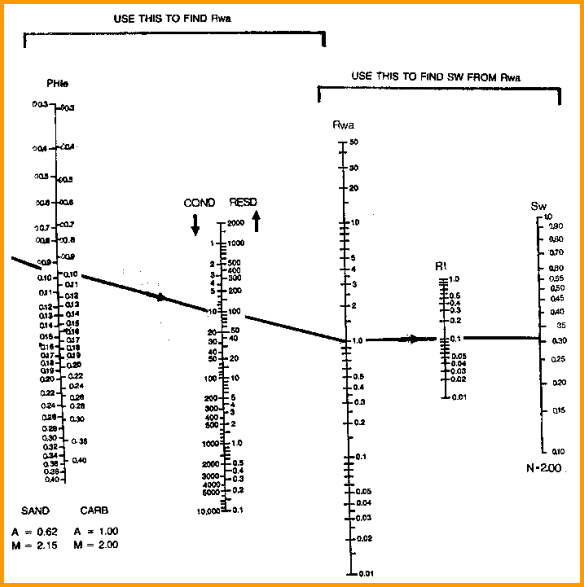|
 Apparent Water
Resistivity (Rwa)
Method
Apparent Water
Resistivity (Rwa)
Method
The Rwa method involves a three step procedure:
STEP 1.
Calculate
apparent water resistivity for all prospective zones in a well,
including water zones:
1: Rwa = (PHIt ^ M) * RESD / A
STEP 2. Select
Rw from minimum of Rwa values for all the other defined clean
water zones.
2: IF Vsh < 0.2
3: AND IF RESD < RESWET
4: THEN RwaFLAG = 1.0
5: OTHERWISE RwaFLAG = 10 ^ 6
6: RW@FT = min (Rwai * RwaFLAG)
STEP 3. Calculate
water saturation from Rwa for each level:
7: Swa = (RW@FT / Rwa) ^ (1 / N)
Where:
A = tortuosity exponent (fractional)
M = cementation exponent (fractional)
N = saturation exponent (fractional)
PHIt = total porosity from any method (fractional)
RESD = resistivity reading on deep log (ohm-m)
RESWET = cut off resistivity for possible water zones (ohm-m)
Rwa = apparent water resistivity (ohm-m)
Rwai = water resistivity of any point in the zone (ohm-m)
RW@FT = formation water resistivity (ohm-m)
Swa = water saturation from Rwa method (fractional)
Vsh = volume of shale (fractional)
 COMMENTS:
COMMENTS:
This is merely a restatement of the Archie equation described
earlier. The basic Rwa formula is displayed below.
Shale
corrected versions of the Rwa equation can be created by rearranging
the Simandoux or Dual Water equations. They should be restricted
to shaly sands where Vsh < 0.40.
 RECOMMENDED
PARAMETERS:
RECOMMENDED
PARAMETERS:
for
carbonates A = 1.00
M = 2.00
N = 2.00 (Archie Equation as first published)
for sandstone A = 0.62
M = 2.15
N = 2.00 (Humble Equation)
A = 0.81 M = 2.00 N = 2.00 (Tixier Equation -
simplified version of Humble Equation)
Asquith (1980 page 67) quoted other authors, giving values for A
and M, with N = 2.0, showing the wide range of possible values:
Average sands A = 1.45 M = 1.54
Shaly sands
A = 1.65 M = 1.33
Calcareous sands
A = 1.45 M = 1.70
Carbonates
A = 0.85 M = 2.14
Pliocene sands S.Cal. A = 2.45 M = 1.08
Miocene LA/TX
A = 1.97 M = 1.29
Clean granular
A = 1.00 M = 2.05 - PHIe

Nomograph for RWA equation (no shale correction)
 NUMERICAL
EXAMPLE:
NUMERICAL
EXAMPLE: |
| 1.
Using data from Sands A, B, C and D as before: |
| |
Sand
A |
Sand
B |
Sand
C |
Sand
D |
| RESD |
20 |
40 |
1.2 |
1.0 |
| PHIe |
0.33 |
0.23 |
0.30 |
0.11 |
| A |
0.62 |
0.62 |
0.62 |
0.62 |
| M |
2.15 |
2.15 |
2.15 |
2.15 |
| Rwa |
2.97 |
2.73 |
0.145 |
0.014 |
| RW
@ FT |
0.9 |
0.9 |
0.036 |
0.015 |
| N |
2.0 |
2.0 |
2.0 |
2.0 |
| Swa |
0.55 |
0.57 |
0.50 |
1.03 |
Sample:
Rwa = (0.33 ^ 2.15) * 20 / 0.62 = 2.97
Swa = (0.9 / 2.97) ^ (1 / 2.0) = 0.55
|

